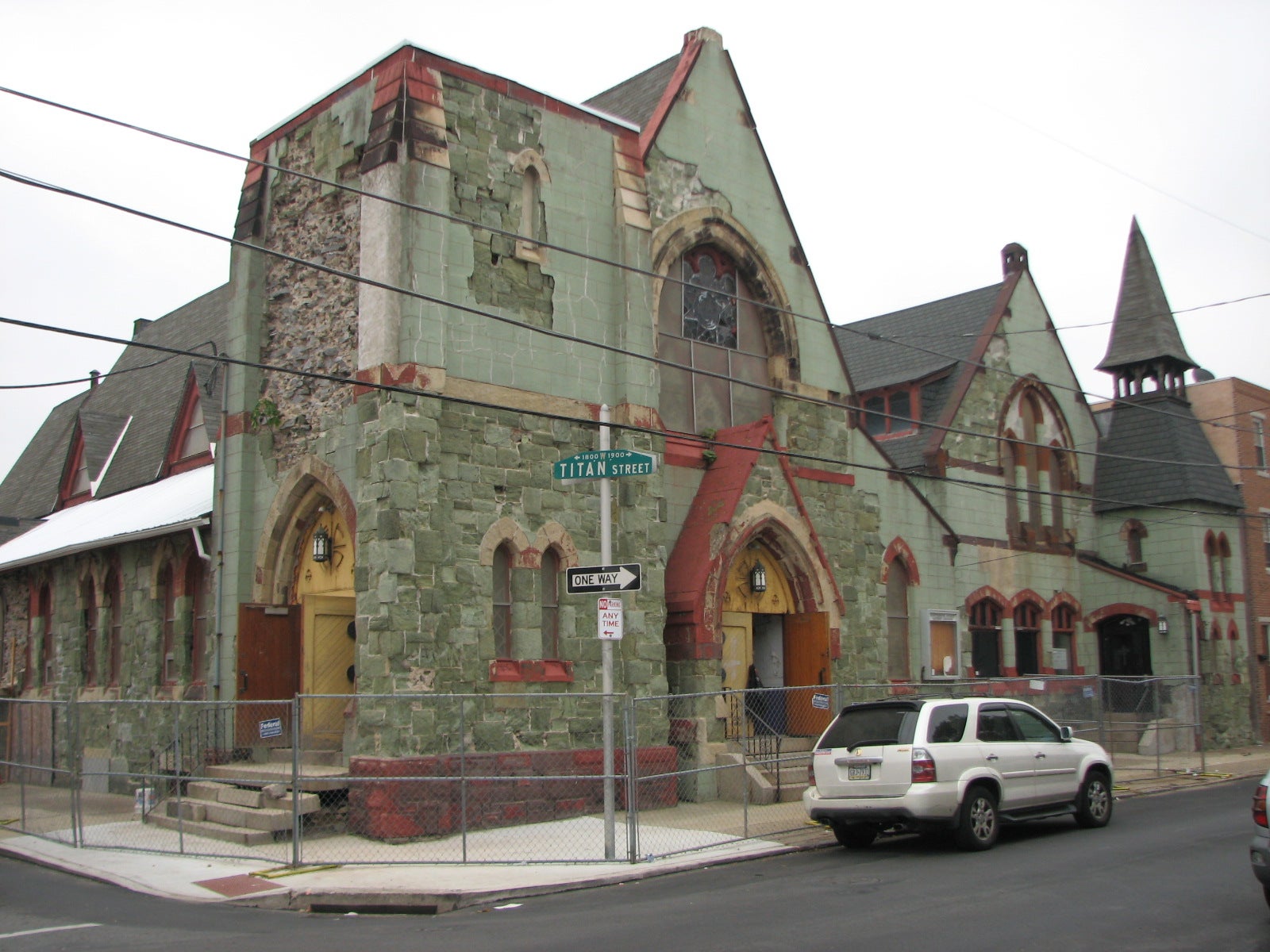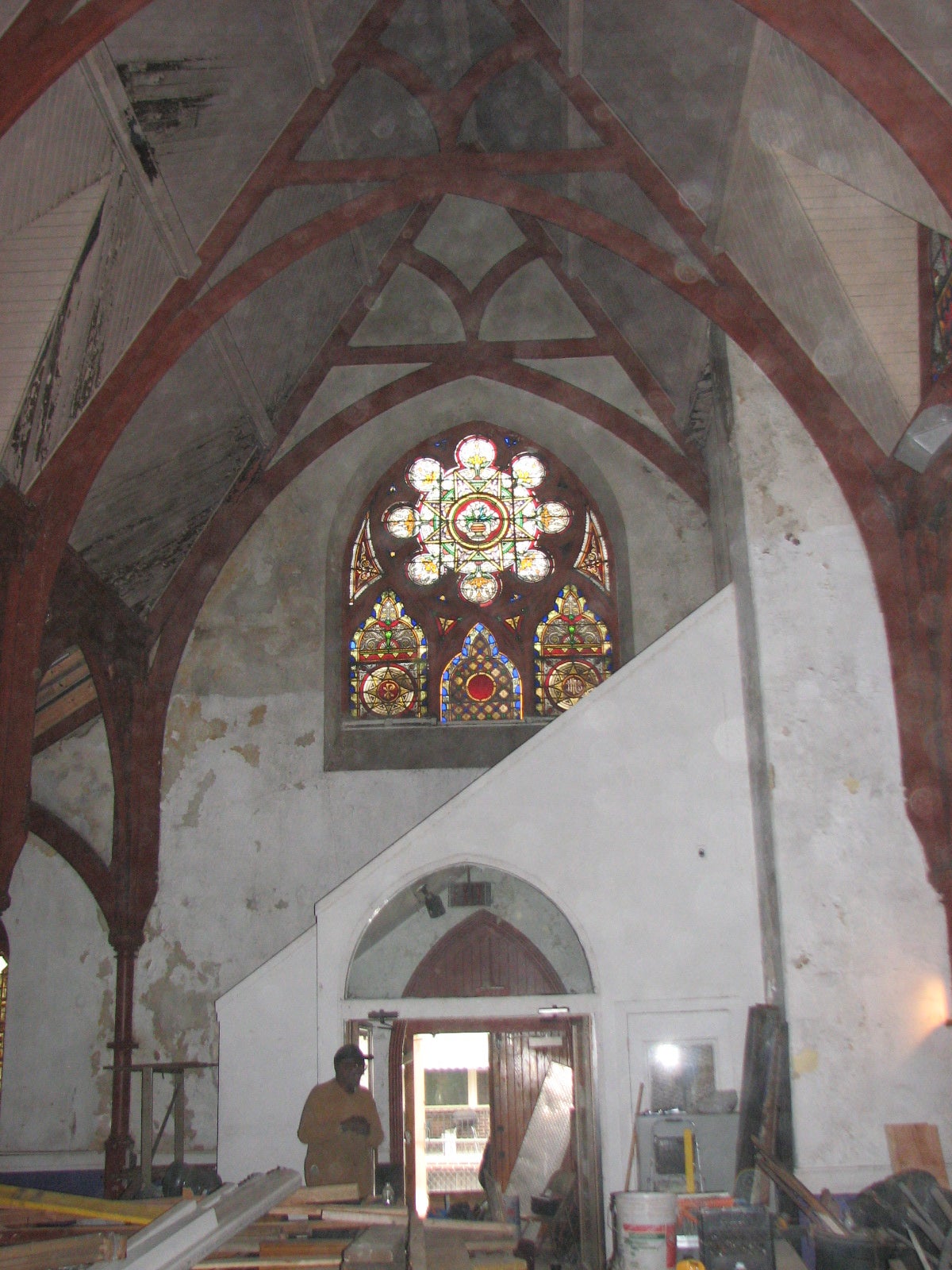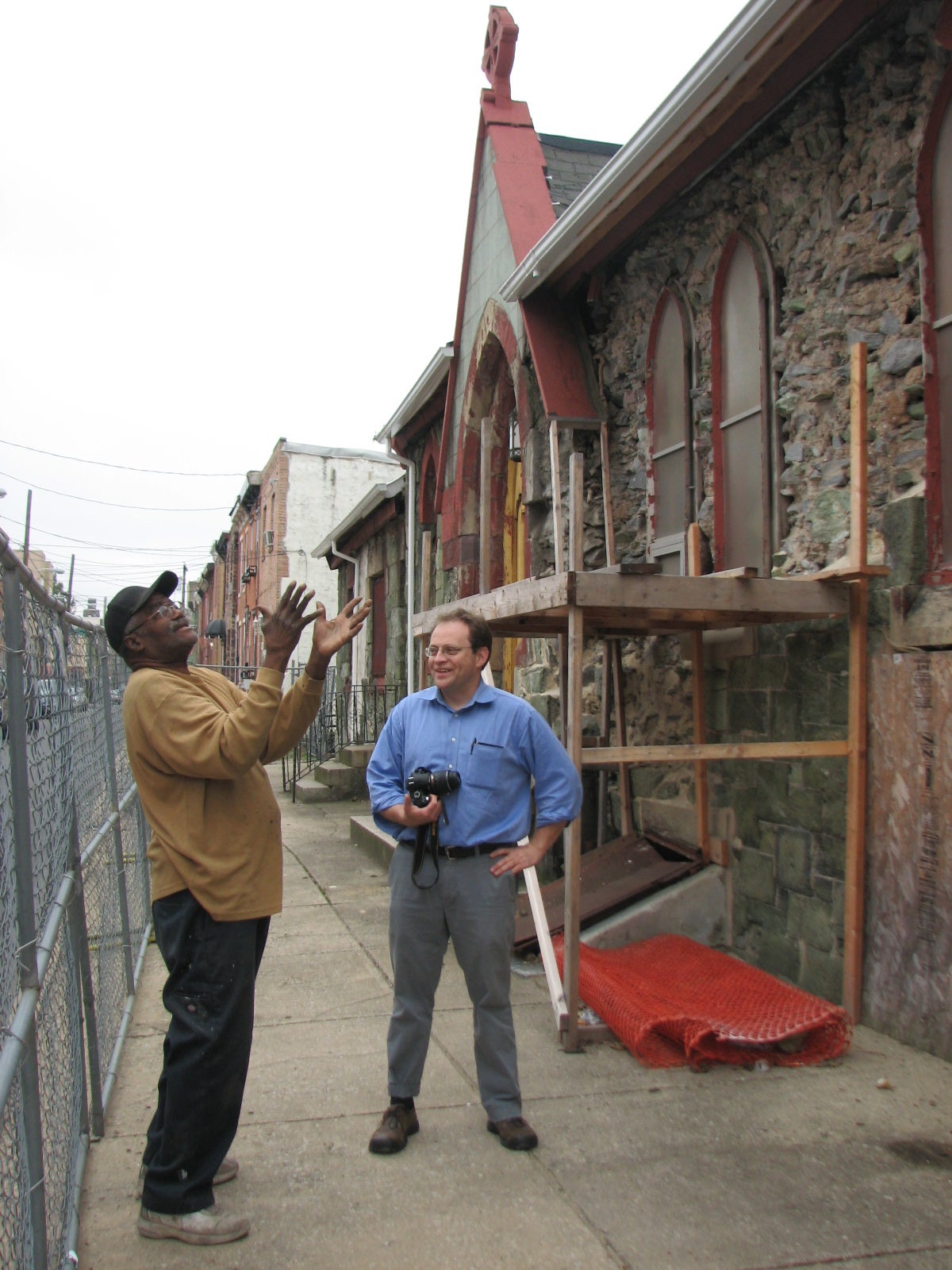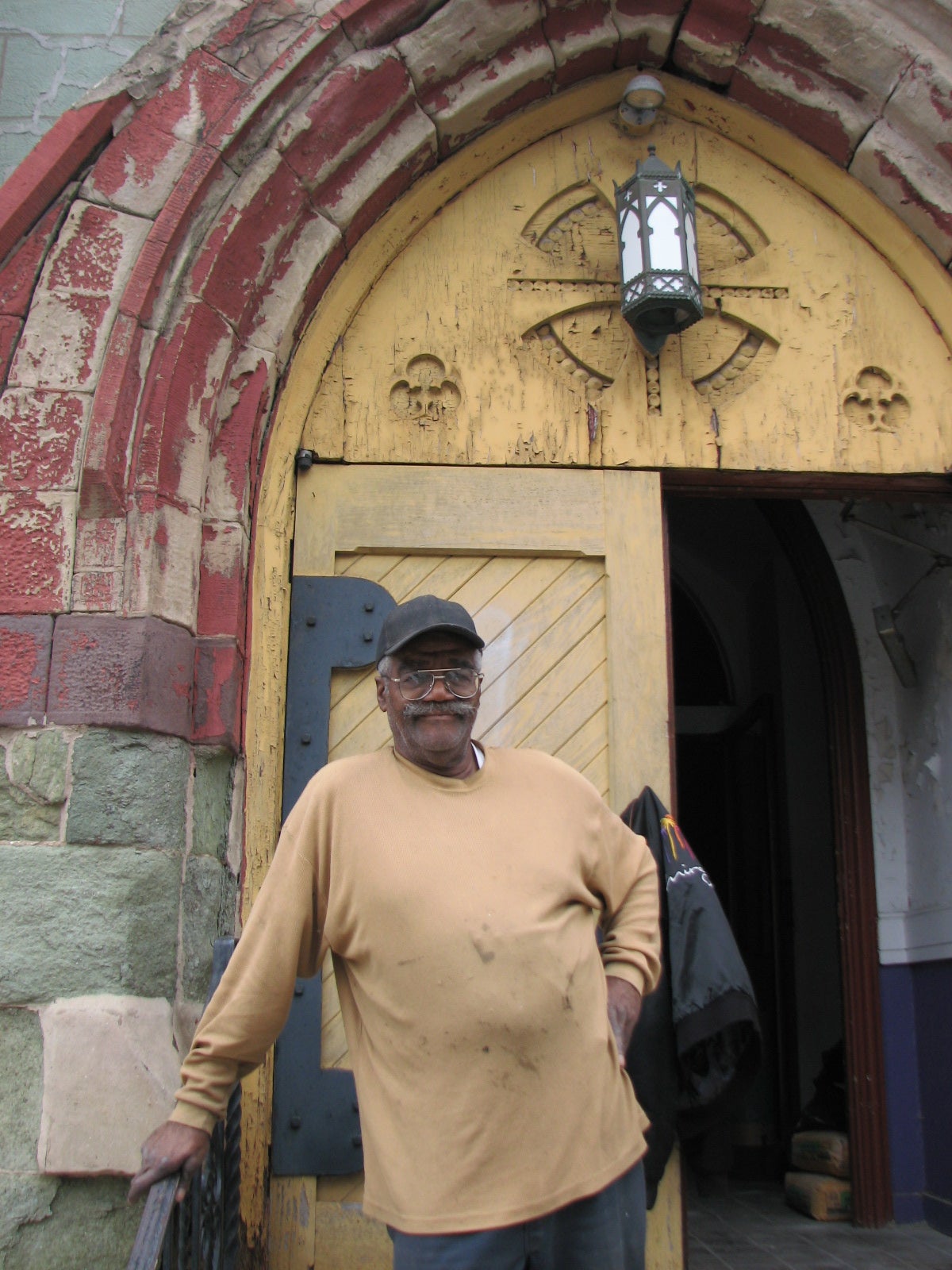Landmark Furness church on the road to salvation
It has survived decades of urban upheaval, deferred maintenance and, in just the past year, two hurricanes and one small earthquake.
Now it looks like the stubbornly standing 19th Street Baptist Church has turned a corner toward salvation.
A year of emergency preservation work on a very limited budget has repaired the gaping holes in the sanctuary roof, diverted rain from washing down and behind the vulnerable serpentine facade, and halted the building’s overall decline.
A mobilization of congregants, preservationists, and Penn faculty members has rescued the 1874 Furness & Hewitt design from imminent demolition and laid the groundwork for the overall restoration of the historical and architectural gem.
Weathering the storm
It didn’t look so good for the South Philadelphia church a year ago.
The unlikely little earthquake that rattled the region in August 2011 and the pounding rains of Hurricane Irene that followed days later washed a portion of the green serpentine veneer and other masonry off the Titan Street side of the church.
The Department of Licenses & Inspection paid a visit, and warned that the building at 1253 S. 19th St. would be demolished if the roof, gutters and other issues were not quickly repaired.
Aaron Wunsch, a University of Pennsylvania assistant professor of historic preservation, read about the church’s plight on the Friends of Frank Furness website. “That was when the notice first went out about the threat of condemnation,” Wunsch said. “A lot of reflexive, Philadelphia-style hand-wringing began after that.”
He contacted Melissa Jest, Neighborhood Preservation Program Coordinator at the Preservation Alliance for Greater Philadelphia. She put Wunsch in touch with Lloyd Butler, a deacon at 19th Street Baptist.
A church meeting was held with former Mayor Wilson Goode, a close friend of the church’s then-Pastor Charles Walker. Goode provided assistance in navigating the city permit process to make temporary repairs to the building, Butler said.
Wunsch applied to the local office of the National Trust for Historic Preservation for immediate stabilization funds. “They had a little money set aside for buildings that had been damaged by Irene, and we got $1,500 from them.”
So Butler, a 72-year-old retired carpenter (“but I feel like I’m 35”); the church’s Rev. Vincent Smith, who was trained as an electrician; and Wunsch began their series of weekend repairs.
“That $1,500 was immediately used in a shopping trip to Home Depot. We bought almost all the roofing material needed for one side of the roof. We knew we had to get it up and board it over before the first winter snow settled on it. The problem with the asphalt layers of roofing was, the newest one was maybe 30 years old. When they get that old and they get wet, they stay wet. And when we shoveled it off we discovered there were termites everywhere.”
The termite damage was mainly in the sheathing atop the rafters and, fortunately, not in the main trusses of the church’s beautiful interior. “The actual structural damage was pretty minimal,” Wunsch said.
Some additional funding, sweat and time was provided by Goode and “other sons of the church,” Butler said, and they continued “to preserve what we have.”
“Our goal was just to stabilize it long enough that cool-headed decisions could be made about the building’s future and the grant-writing going forward,” Wunsch explained. “There was no thought that the work we were doing was going to be beautiful restoration or permanent. But it’s already so much better than it was,” Wunsch said. “You can literally feel the building drying out.”
A singular work
Wunsch’s colleague, Frank Matero, a Penn professor of architecture and historic preservation, also heard about the problems at 19th Street Baptist just after Irene blew through. “I was completely unaware of the existence of the building. … When I went down to see it, I was bitterly thunderstruck.
“Given its presence and location, it is an honest-to-God landmark. It meets every criteria for what a landmark is: architecturally, historically, contextually, and it’s a remarkable design. It commands that corner with its components of the parish house and church building. It is diminutive in size, but it is monumental in scale. If you knew nothing about Furness, you still would recognize it is a unique and singular work.”
The firm of Furness & Hewitt was hired by Margaretta Lewis, a congregant of St. Peter’s Episcopal Church, the 18th century landmark at 3rd and Pine Sts., to design a missionary chapel at 19th and Titan. They created a High Victorian masterwork whose original name was the Church of the Holy Comforter.
It is one of the few surviving post-Civil War religious structures designed by the Furness firm, and one of its most colorful.
“What’s interesting to me is all the masonry materials from the period that Furness brought into this design,” Matero explained. “It is literally a textbook of American building stone.”
A similar effort is evident in the interior courtyard passages of City Hall. The government building has a “monolithic marble exterior,” but the interior spaces contain “a riot of building stone,” Matero said. In the 1870s, when Philadelphia hosted the Centennial Exhibition, American builders were renowned for “polychroming – the mix of masonry materials, celebrating color and texture.”
Matero believes Furness purposely used this wealth of materials for the church to “show the prowess of American building stone. If those kinds of things excite you, it’s a very terrific building.”
The serpentine came from Chester County, and is mainly found in buildings in Philadelphia, New Jersey, Baltimore and Washington. “It was a material that had particular local significance, and it was not found anywhere else,” Matero said.
An 1880 census of Philadelphia buildings cited six significant buildings of serpentine: Penn’s College Hall, Beth Eden Church, Holy Communion Church, Girls Normal School, the original Academy of Natural Sciences building, and the church on 19th Street.
The other materials used at the church were yellow sandstone, probably from Ohio; and brownstone and white marble from Pennsylvania.
“There was also an incredibly polychromatic slate roof. The surface area was huge. It must have had an incredible effect when it was all together,” Matero said.
“Despite the fact that we’re seeing a pale reflection of that now, it is still a robust design that holds up quite well, even in its current condition. When I saw it for the first time, it was heartbreaking. I wanted to do something to help the congregation.”
A teaching opportunity
Matero joined the growing circle of support for the church, including the Preservation Alliance, Partners for Sacred Places, and the Hidden City website. “People mobilized, as in the case of any needy victim after a storm,” Matero said.
He assigned his masonry seminar class to perform a survey and conditions assessment of several churches in the South Philadelphia neighborhood. “That’s always the first step: You need to document and record the condition, and from there begin to look at the diagnostics, problems and potential solutions.”
For the restoration of the serpentine on College Hall in the early 1990s, the decision was made to replace most of the stone with artistic pre-cast, given the advanced deterioration and because the stone itself is no longer being quarried. “It’s a stone that can range widely in quality unless you hand-pick the stones very carefully,” Matero said.
“Given the rarity of remaining buildings of serpentine and knowing the church couldn’t afford a total replacement, the first option would be to try and preserve the existing masonry.”
The challenge is finding a way to improve the performance of the serpentine and reattaching it to the building in a way that is more durable.
“It is exactly the kind of project we look for at Penn Praxis and the Architecture Conservation Lab. It presents the intersection of needed research, education, and community service. And it’s on a remarkable building.”
One of Matero’s graduate students, Catherine Brown, has elected to pursue her thesis on testing the effects of various consolidants – chemical compounds that fortify weathered stone — on the serpentine.
“For a stone that is so locally associated with the late 19th century and the rise of Victorian exuberance, it is a stone that hasn’t had much conservation study, maybe because it doesn’t have national prominence,” Matero said. “But it’s as local as soft pretzels and cheesesteaks, and it’s certainly something we need to address. There are many buildings with serpentine in this area, and this project could benefit a great many homeowners and institutions.”
Penn research into grouting for the reattachment of historic masonry has gone on for many years, and has been applied on the medieval walls of Cairo and the Gordion gate in Turkey. “These are world-class monuments which have had similar problems” and have been the subjects of research in the school’s labs and in the field. “We’ve developed some tried and true methods for the reattachment of masonry veneer,” Matero said.
By May, he believes his team will have a solution for the treatment of the stone at 19th Street Baptist. In the fall, he’d like to bring a group of grad students and professionals together to lead a field-based course that develops and demonstrates methods of conservation of the church building.
The conservation teaching project will require some support, and Matero has already received commitments from suppliers and contractors for contributions of equipment, materials and time.
“I think we will become a catalyst for helping this situation through advocacy, research and education, using this program and the school for a platform,” Matero said.
Funding reconstruction
The do-it-yourself phase of the church’s quick-fix preservation is coming to an end for Deacon Butler and his crew.
They have patched the roof and replaced the gutter system. They have collected and saved the serpentine and Wissahickon schist stones that either fell off or were removed for safety. The rubble walls themselves are thick and solid. The sanctuary floor has been replaced. The interior woodwork is in good condition. Even the original stained glass windows, designed by the New Jersey firm of Slack & Booth, are in place, except for the row that had been been stolen but eventually recovered.
Still, the restoration and reconstruction of the building has been estimated at $2 million to $3 million.
The Penn faculty members believe the funding will come, “but first there must be a structure in place for receiving grants and for receiving money of the kind that would be needed for doing this,” Wunsch said. In the meantime, now is the time to perform the much needed conservation planning and research.
He and Matero have discussed the need for a nonprofit “friends” group to serve in the role of receivership for the church.
“Funding would not come from a single place. If a credible receiver is established, you’re well positioned to get a grant for serpentine conservation. There are places — from the private sector to the Getty Foundation – that really want to see a study of that kind of stone being preserved,” Wunsch said.
“For the rest of it, I think that once there is interest generated, you potentially have a lot of people interested. … I have not been put off by the fundraising puzzle if the building is dry, if the building is stable, and there is time to develop grant proposals, which is really the next step.”
Even if the funding proves difficult, “it’s not going to deter us,” Matero said. “We have plenty to offer and there’s much we can do with the resources we have. There certainly isn’t a more needy case.
“I’m convinced the tide will turn when the congregation, the public and the professionals can actually see the visible results of what is possible. One of the goals in the fall will be to execute a demonstration project on a portion of the façade restored to show what can be done.”
Contact the writer at ajaffe@planphilly.com.
WHYY is your source for fact-based, in-depth journalism and information. As a nonprofit organization, we rely on financial support from readers like you. Please give today.







